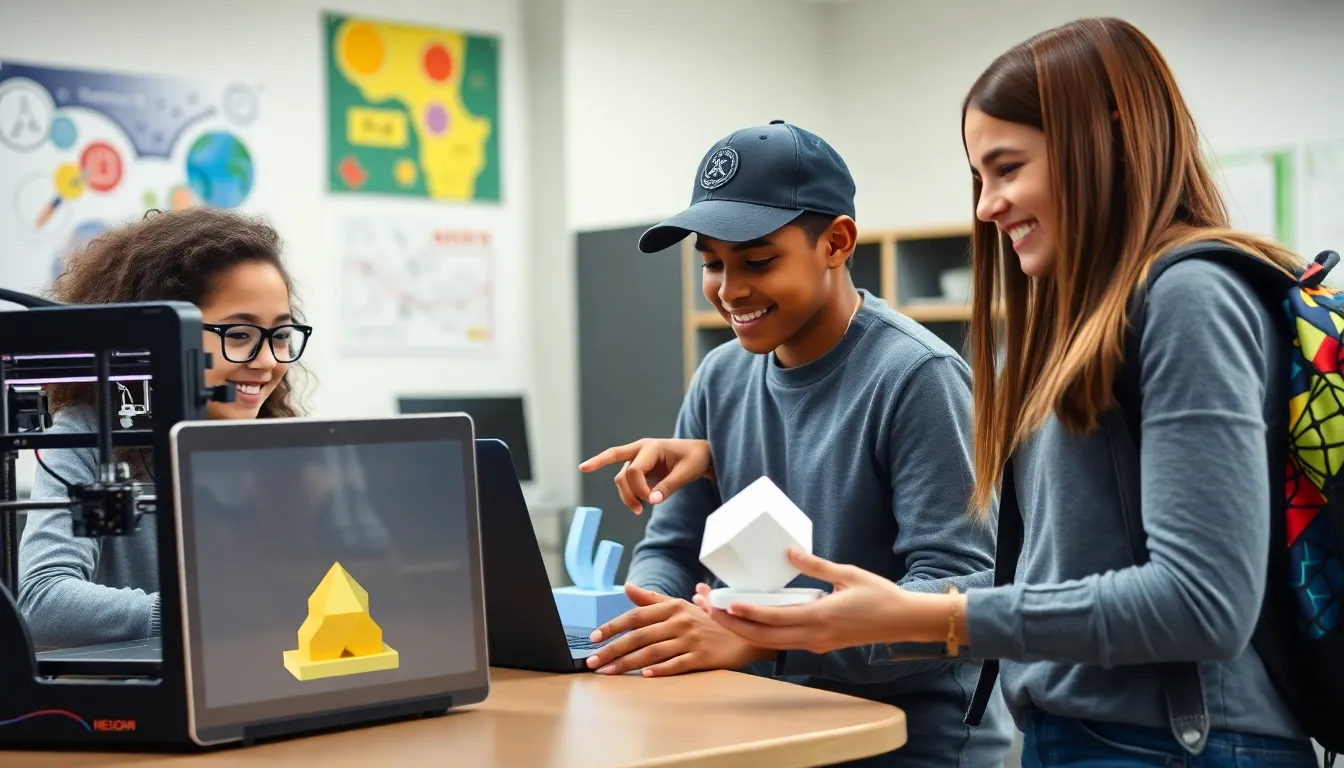In a world where creativity knows no bounds, 3D printing has emerged as the ultimate playground for hobbyists. Imagine turning your wildest ideas into tangible reality—one layer at a time. Whether it’s crafting custom figurines or designing unique gadgets, this technology invites everyone to unleash their inner inventor.
Table of Contents
ToggleOverview of 3D Printing for Hobbyists
3D printing provides hobbyists with an innovative platform to express their creativity. Various types of printers, such as FDM, SLA, and SLS, cater to specific project needs and skill levels. Many enthusiasts enjoy creating custom figurines, unique gadgets, or even functional tools using this technology. This versatility empowers individuals to transform ideas into tangible products.
Resources for beginners abound online, including tutorials, forums, and instructional videos. Community engagement helps hobbyists share experiences and gain insights from others. Equipment options range from entry-level printers priced under $200 to professional models exceeding $2,000. Hobbyists typically choose tools that align with their objectives and budgets.
Materials play a crucial role in the 3D printing process. PLA and ABS are popular choices for beginners due to their ease of use and availability. Other materials, such as PETG and Nylon, offer enhanced strength and flexibility for specialized applications. Understanding these options helps hobbyists select the right filament for their projects.
Software also plays a key role in the design and printing process. Programs like Tinkercad and Fusion 360 offer user-friendly interfaces for creating and modifying designs. More advanced software caters to experienced users seeking intricate models and designs. Mastering these tools can elevate hobbyists’ projects to a professional level.
Exploring 3D printing opens new avenues for creativity. Hobbyists can experiment with various designs, materials, and techniques. Engaging in this hobby fosters a sense of community, encouraging collaboration and innovation among peers.
Benefits of 3D Printing
3D printing offers numerous advantages for hobbyists, enhancing creativity and enabling practical applications.
Customization and Personalization
Customization ranks high among the benefits of 3D printing. Individuals create bespoke items tailored to their specific tastes. They design unique figurines that reflect personal interests or modify existing designs to fit individual preferences. Personalization becomes even easier with various online repositories of 3D models. Hobbyists find inspiration and resources to craft custom solutions that standard products can’t provide. This level of personalization empowers users to express their creativity, making every project distinct.
Cost-Effectiveness
Cost-effectiveness plays a crucial role in attracting hobbyists to 3D printing. Often, creating personalized items costs significantly less than purchasing them from retail stores. While initial printer investments may vary, ongoing material costs remain manageable. 3D printing allows enthusiasts to experiment with different designs without the financial stress of traditional manufacturing. Many find that they break even after a few projects, especially when producing functional items or replacements. Budget-friendly options available in the market allow hobbyists to focus on their creativity without overspending.
Common Applications for Hobbyists
Hobbyists use 3D printing for various creative projects. These applications showcase the technology’s versatility and capacity to enhance artistic expression.
Model Making
Model making represents a popular application for 3D printing among enthusiasts. Hobbyists craft intricate architectural models, miniatures, and prototypes that demonstrate their concepts. Patterns and designs can be customized according to specific needs. Designers often turn to online repositories for inspiration, selecting from countless available models. Using 3D printing, they easily achieve precise detailing and complex geometries that traditional methods can’t replicate. Printing in various materials, such as PLA for display models or resin for high-detail finishes, adds another dimension to their creations.
Home Décor
Home décor items also benefit significantly from 3D printing. Creatives design unique vases, wall art, and furniture accents tailored to personal tastes. By leveraging customizable templates, individuals craft one-of-a-kind pieces that enhance their living spaces. This approach allows for exploration of trendy designs or classic styles, matching any home aesthetic. Additionally, hobbyists enjoy the freedom of experimenting with colors and textures, which elevates their decorative efforts. Cost-effective production makes it viable for enthusiasts to create multiple iterations of their ideas, ensuring they can perfect their designs before displaying them prominently.
Getting Started with 3D Printing
Diving into 3D printing involves understanding the basics and selecting the right equipment. Starting can feel overwhelming, but breaking it down makes the process manageable.
Choosing the Right 3D Printer
Selecting a 3D printer requires considering project needs and personal experience. FDM printers are popular for beginners due to their ease of use and affordability, making them ideal for creating custom items. SLA printers offer high detail, suitable for intricate designs and professional results. SLS printers, while pricier, provide excellent strength, perfect for functional parts. Evaluating options based on budget and intended use proves essential for hobbyists. Online reviews and comparison charts can guide the decision-making process, providing clarity on which model fits best.
Essential Materials and Tools
Choosing the right materials impacts the quality and durability of finished projects. PLA stands out as a user-friendly option for beginners, as it prints easily and offers a variety of colors. ABS provides greater strength but requires more advanced settings and a heated bed. More experienced hobbyists may explore PETG for its flexibility and durability, while Nylon suits specialized applications needing higher performance. Essential tools like a quality slicer software help transform designs into printable files. Nozzle cleaning tools and a calibration gauge enhance the printing process, ensuring better results and fewer frustrations.
Challenges in 3D Printing
3D printing presents several challenges for hobbyists that can impact their creative journey.
Learning Curve
Navigating the learning curve poses a significant hurdle. New users often face difficulties mastering design software and printer settings. Tutorials and online forums provide substantial help. Familiarity with common issues is crucial for effective problem-solving. Skilled hobbyists suggest starting with user-friendly software like Tinkercad and gradually moving to more complex platforms. Confidence grows through hands-on practice and experimentation. Supportive online communities offer tips and troubleshooting advice to aid in this learning process.
Maintenance and Upkeep
Regular maintenance is essential for optimal printer performance. Clogged nozzles, bed leveling issues, and worn-out parts can disrupt projects. Cleaning and calibrating printers frequently prevents many common problems. Users should regularly inspect and replace worn components to ensure longevity. Keeping materials stored properly minimizes moisture absorption and degradation. Documented maintenance schedules enhance reliability and print quality. Although upkeep requires time and effort, it significantly contributes to successful printing experiences.
3D printing opens up a world of possibilities for hobbyists eager to unleash their creativity. With a variety of printers and materials available, individuals can tailor their projects to suit personal preferences and skill levels. The accessibility of online resources fosters a supportive community where learning and sharing ideas thrive.
As hobbyists dive into this innovative realm, they not only create unique items but also develop valuable skills along the way. Embracing the challenges of 3D printing can lead to rewarding experiences and a deeper appreciation for the art of making. Ultimately, the journey of 3D printing is about exploration and self-expression, making it an exciting venture for anyone passionate about creativity.






